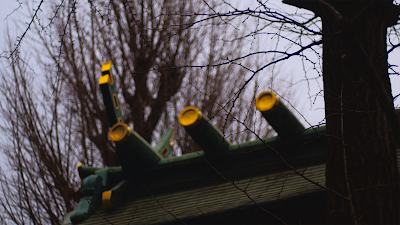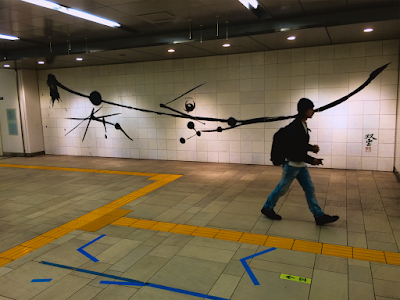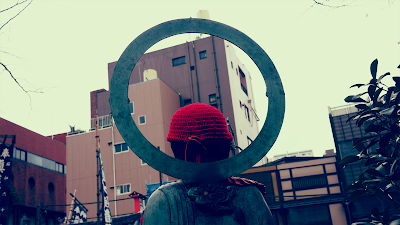From Bujinkan Santa Monica by Michael Glenn
 |
| 柴又八幡神社 Shibamata Hachiman Jinja, photo Michael Glenn |
Another Bujinkan theme that Hatsumi Sensei has been expressing the last few years is the use of 呼吸 kokyuu (the breath), 指 yubi (the fingers), and 目 me (the eyes). These three are not to be taken individually. They must be connected in the same way that the ripples on a pond are connected by the stone that skipped across it.
In one cold December class Hatsumi Sensei described this for us,
"(the eyes and the breath are) connected like skipping a stone. It’s connected together but really you disappear. Take the eyes and the fingers for jissen. In a real situation you don’t want to just go for them, you just kind of let them happen along the way. Take the eyes, the fingers, and stop the breathing."These three things can be thought of as kyūsho. They are weak points on even the strongest opponent. If you attack the eyes, you destroy his ability to fight. The fingers are very sensitive to pain and break easily. And if you stop or interrupt the breath, the entire body and mind stops with it.
As always, Hatsumi Sensei embeds layers of meaning and wordplay into the things he shares with us. The word 呼吸 kokyuu means breath, but it also can be translated as a knack, a trick, or a secret for doing something. Hatsumi Sensei described one of these secrets in another class I went to,
"Don’t grab and hold, just move like this with the body. The finger hooks on here. With this timing, with this rhythm."Even though it wasn’t translated directly, Soke actually said 呼吸から愛人 kokyuu kara ai jin, this is the harmony of the breath between lovers. This means you match your movements or your breath to the same rhythm as the breath of your opponent. You harmonize and become one with him. Then when you break that rhythm, it shatters him like a wine glass.
In case you haven’t seen that happen, a wine glass can be shattered by sound (the breath or voice of a singer). This happens because the glass has a natural frequency at which it vibrates. The singer first resonates with this frequency, then breaks that by going beyond it.
Hatsumi Sensei said we can use the finger to attack the rib cage in a way that interrupts the breath. I witnessed this, but since it is a kuden, I would have to show you in person. Don’t be afraid to ask me to hurt you next time you see me!
Hatsumi Sensei added that this is why we don’t have to avoid a strike. Instead we interrupt the opponent's breathing. This becomes like sutemi. Here we find the feeling of being able to control with just one finger.
The word for eyes or eyesight in Japanese can use different kanji as well. One of them is 目 me which can be translated as insight. Another is 明 mei which is a brightness or clarity of vision.
And the finger indicates the connection or link between these things. We must open up to these connections when we train on the Bujinkan themes. Remember the real training happens in your own breath and your own insight.



